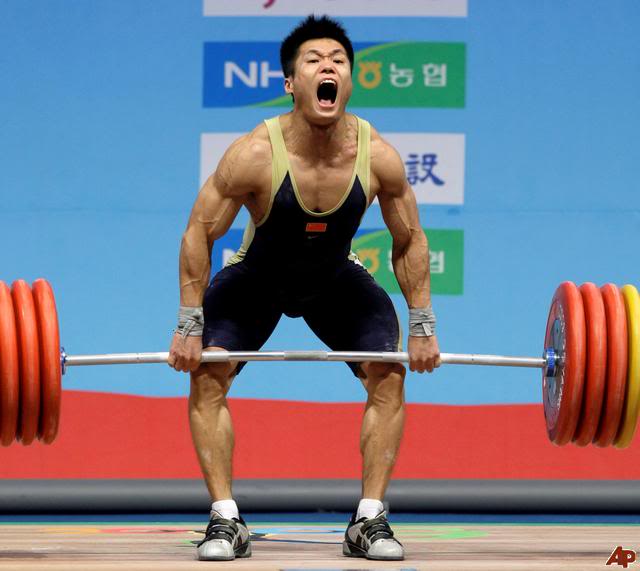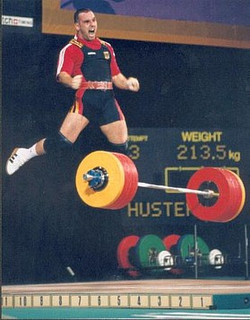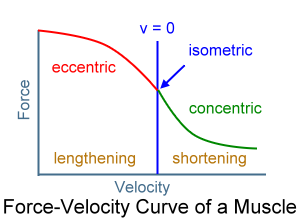Ideal athletic performance comprises a positive contribution of various physical (strength) qualities that are necessary to enhance the movements (skills) of the athletic endeavor. One of these essential physical qualities is power. Power may be expressed as Work divided by Time (W/t) where Work = Force X Distance and Force = Mass X Acceleration. Therefore one method of consideration to enhance an athlete’s physical quality of “power” is for the athlete to lift a specific programed weight intensity (mass) at a high velocity (acceleration) or a higher weight intensity (mass) at the same velocity (acceleration).
Power is an important component of athletic performance. There are a vast selection of performance enhancing training exercises, methods, and implements available to the Strength and Conditioning (S&C) Professional to improve this important physical quality. Certainly no one specific exercise or method of training is the only option. Furthermore there is no “one size fits all” approach, as every athlete should be considered as an individual with his or her own specific genetic makeup, anatomical structure, and training as well as medical history.
One training approach for consideration to enhance the physical quality of power is the incorporation of the exercises and principles of Olympic Style Weightlifting (i.e. the Clean and Jerk, and the Snatch). Olympic Style Weightlifting movements have demonstrated some of the highest human power outputs of all the resistance training exercises. Discussions concerning the Olympic Lift’s (OL’s) as a chosen method of “power” development are often controversial, but these exercises do provide both the S&C Professional as well as the athlete with some unique advantages when compared to other methods of “power” training.
Many S&C Professionals are familiar with the concept of “triple extension” and the utilization of the OL’s for power enhancement. That said, this article will also discuss the additional benefits as well.
The Nervous System
The OL’s allow for a specific training of the nervous system. The common denominator of the OL exercises is speed as many of the various components of the OL’s take only fractions of a second to perform. This type of “power” training shortens the time of motor unit recruitment, especially in the fast twitch type muscle fibers while increasing the tolerance of the motor neurons to increased innervation frequencies. A better synchronization of the motor units and their firing patterns also occurs as muscles also learn to discharge a greater number of muscle fibers in a short period of time.
These exercises also enhance intramuscular coordination, which is the ability for the agonist and antagonist muscles of a joint to cooperate together and effectively perform a movement pattern. This enhanced intramuscular coordination allows for an improved speed of movement, thus optimizing power production.
The Coactivation Index
A unique benefit of the OL’s that is very often omitted in the content of articles and discussions is the subject matter of the muscle coactivation index (CI). During an athletic movement there is a relationship between the agonist and antagonist joint musculature. Agonists (synergists) are muscles that work together to achieve a specific movement while antagonists are muscles that oppose the agonist’s movement. During joint movements the agonist and antagonist muscle activity can be measured and compared resulting in the CI. The CI is calculated by dividing the EMG data of the antagonists by the agonists as expressed as a percentage of the EMG value during the maximum voluntary contraction (MVC) and multiplying by 100%.
The great sprint coach Charlie Francis would often indicate for an athlete to achieve optimal athletic performance their muscle groups would need to coordinate both relaxation and activation throughout the movement (skill) for an ideal force production to occur. Tudor Bompa has also stated that the most skilled athletes are those that have the ability to completely relax the antagonist muscle groups during a movement. It should be noted that rigid and rough movements are a result of poor coordination between agonists and antagonists.
“Traditional” strength type exercises such as the squat and deadlift may actually increase the CI at the corresponding agonist/antagonist joint musculature, as this type of strength training will result in enhanced joint stability. On the other hand the OL’s have been demonstrated to decrease the CI as this type of training mechanism allows for a reduced antagonist muscle group contribution resulting in an superior overall “power” type exercise performance.
The Barbell
The barbell is the weighted implement of choice for the athlete’s performance of the OL’s. Barbells offer some unique benefits when compared to other types of weighted training implements such as dumbbells, kettlebells, and weighted vests. Some of these benefits are as follows:
Exercise Intensity – no other exercise training implement may be loaded with as high a weight intensity (load) for the performance of a high velocity movement like the barbell. Exercise intensity (stress) is the single most important training variable necessary for physical “adaptation”. Without a sufficient stimulus to disrupt the homeostasis of the body adaptation will not occur, thus the athlete will just be wasting valuable training time. The literature provides evidence that weight intensities as low as 10% 1 RM in novices and up to approximately 40% of an athlete’s 1 RM will enhance power development. However, there is also evidence that heavier weight intensities will enhance power development as well. Though these heavier weight intensities may be performed at lower bar velocities when compared to lighter loads, these heavier load intensities will not only continue to improve power output but will also improve necessary absolute strength levels. Frequently in the arena of athletic competition an athlete must initiate a high power output against an additional external resistance. We have all witnessed a running back breaking a tackle, a wrestler “locked up” with their opponent, a lacrosse faceoff, and a basketball power forward tied up under the boards to name a few.
Metabolic Cost – Load also influences the metabolic cost of training. Larger training loads will have an increased effect on the mechanical work performed (i.e. Work = Force X Distance), thus with similarly programed exercise training volumes, larger weight intensities will increase metabolic cost (i.e. kcal/min, VO2 max) resulting in an improved work capacity. Barbells are more practical in accomplishing this goal of exposing the athlete to high loads compared to other aforementioned training implements.
The Olympic Style Lifts and the Development of the Various Physical Qualities of Strength
The utilization of the OL’s in conjunction with a barbell will not only improve the physical quality of power (explosive strength), but acceleration and reactive strength qualities as well.
Acceleration – The ability for an athlete to accelerate is an important component for success in many arenas of athletic competition i.e. the acceleration phase of sprinting. The ability to accelerate transpires from a “preparatory” slower movement velocity (muscles are already contracting) followed by a higher velocity (acceleratory) movement. Dr. Loren Chiu uses the analogy of a NASCAR racecar going around the track at a specific constant speed and then suddenly increasing speed (accelerating) to pass the car in front. During the OL exercise performance the transition of the barbell from the 1st pull through to the 2nd pull requires the athlete to accelerate the bar from a slower preliminary speed.
Reactive Strength – Reactive Strength (RS) training incorporates the stretch shortening cycle (SSC) and is typically accomplished via plyometric or “shock” type training. Another unique component to performing an Olympic Lift with a barbell is the second knee bend that must occur prior to the 2nd pull to clear the barbell from the front of the knees so that the barbell may continue to move vertically to ensure exercise success. This second knee bend produces a SSC/RS quality at both the Patella and Achilles tendons of the lower extremity, thus enhancing the neuromuscular training of the musculoskeletal system for enhanced force output. No other weighted implement i.e. dumbbell, kettlebell, weighted vest, etc. will produce this SSC/RS phenomenon as exercise performance with these other types of weighted implements are placed lateral to the knees, between the legs, or worn upon the body. Since these other various types of weighted implements to do not pass in front of the knees/legs during exercise performance the second knee bend action is not present (necessary) and only knee extension is required. The “catch” phase, when the athlete must accept a heavy clean or snatch in the bottom position, or when driving him or herself under a heavy jerk will improve the athlete’s RS qualities as well.
The Rate of Force Development
Although training for the Rate of Force Development (RFD) like acceleration has the athlete with the intent to move the weight intensity rapidly, unlike the accelerative abilities the RFD occurs when the initial bar movement velocity is equal to zero. Therefore this type of training requires peak force generation to occur near the start of the movement thus generating maximum force in a minimal amount of time. Dr. Loren Chiu uses the analogy of a drag racing car that must produce high forces/torque from a dead stop. Examples also include a sprinters start or a squat jump.
The RDF is also very important criteria in the opinion of many rehabilitation professionals for an athlete’s return to athletic competition. Presently there are ACL studies demonstrating that ‘acceptable” return to sport strength levels occur at appropriately 6 months post-surgery, however the same “acceptable” levels of RFD may take up to one year. Therefore, the OL’s as well as variations of the OL’s may be utilized as part of a lower extremity rehabilitation protocol to accelerate the restoration of the RFD after lower extremity pathology and/or surgery. We employ the use of the OL’s exercises and principles with both the rehabilitation and post-rehabilitation training of the athlete’s that we work with at our facilities.
RFD is trained with the OL’s by having the athlete lift the weighted barbell from different dead stop bar positions. Various height “pulling blocks” are used to achieve this goal. The three (3) positions commonly utilized are; “below the knee”, “at the knee”, and “above the knee”. Other bar positions to consider would include at the mid-thigh and at the hips (power position). This is to be determined by the S&C Professional based upon the individual needs of the athlete as to which pulling position(s) will be most beneficial.
Deceleration
The athlete’s ability to decelerate is an important criterion to excel in athletic competition. Tudor Bompa has indicated that in all sports the ability to accelerate is important, but similarly is the ability to decelerate, especially when considering the need to change direction. The ability to decelerate requires strong eccentric capacity of the musculoskeletal system. It is well known that an individual can lower a much heavier weight via an eccentric muscle contraction when compared to the maximal weight that may be lifted concentrically. Some coaches may have their athletes execute “negatives” during an exercise performance as these heavy weight intensities are lowered at slow speeds to enhance strength qualities. However, in the athletic arena, eccentric muscle contractions occur at high speeds in order to decelerate as in landing from a jump, the deceleration phase of pitching, changing direction to avoid an opponent, etc. Thus wouldn’t training eccentrics at higher speeds be more applicable to athletic performance? In review of the force velocity curve one can see that during an eccentric muscle contraction, greater tension is produced at higher velocities.
During the “catch” phase of an OL the athlete has to drop their body under the bar at a high velocity to receive the barbell in the bottom position prior to the barbell “crashing” back to the ground surface area. This ability requires a high-speed eccentric contraction. It is important to note that the athlete must support and control the combined total load of the barbell as well as his or her body weight. This “event” occurs in a very short period of time and produces high levels of force that need to be absorbed in a ballistic manner. Some may argue that this type of training is unsafe, however we consider this component of the exercise performance as preparation for the unpredictable high forces that occur on the playing field and in essence “armor coat” the athlete as positive soft tissue adaptations will occur as noted in Davis’ law.
Final Thoughts
The athlete’s ability to produce high velocity training movements for the enhancement of a multitude of physical qualities is critical for athletic success. The premise of this article is that the classic barbell Olympic Weightlifting movements provide a very practical and effective training methodology. This combined with the large number of assistant OL’s performed at different positions, offers the athlete a sufficient training variety necessary for enhanced athletic performance.
Robert A. Panariello MS, PT, ATC, CSCS
Professional Orthopedic and Sports Physical Therapy
Professional Athletic Performance Center
New York, New York
Professional Orthopedic and Sports Physical Therapy
Professional Athletic Performance Center
New York, New York




No comments:
Post a Comment